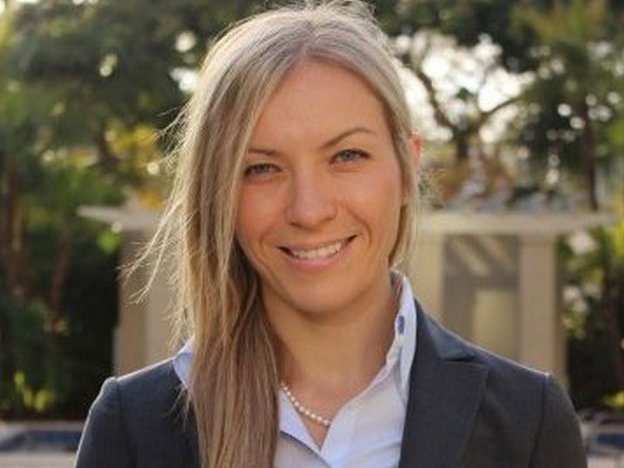
Kate Matrosova was an experienced hiker who grew up in Southern Siberia in Russia. She was born as Ekaterina Matrosova, but used Kate. No stranger to bad weather conditioons. Kate originally came to America on a student VISA. After receiving a masters degree in Financial Engineering, she worked for a variety of firms on Wall Street. Kate and her husband lived in NYC, and they weren't strangers to the Catskill Mountains. If you had met her, you would have remembered her. She was always smiling, humble, befriending people, and down to earth. If you worked on Wall Street in NYC, you know that she was a brilliant Financial Engineer, that she was liked by everyone who met her. She was loved and respected by everyone. Kate Matrosova was an exceptional person.
At the time of this incident, she was a 32 year old. She was extremely fit and a highly intelligent mountaineer. She wasn't a world class runner, but had run a number of marathons. Kate has climbed four big peaks (Aconcagua, Elbrus, Kilimanjaro and McKinley). She had also done a number of other 15-25k mountains. Most of her free time over the last 5 years had been spent climbing difficult mountains and training. She was also ranked #2 ranked female for Judo in the USA for her age group. She had all the gear you would expect for this particular endeavor. This incident occurred on the Presidential Mountain Range of the White Mountains in New Hampshire. Her plan was to day hike and summit the four presidential mountains on February 15, 2015. It was her way of celebrating President's day. She had done the same hike about a month earlier, so she knew what to expect in the terrain. Her plan was to start very early in the morning, and have her husband pick her up on the other side of the range in the evening of the same day. Kate had the typical gear list that most experienced hikers would carry. But, she didn't have a sleeping bag, bivy, or snowshoes. She planned on hiking light and traveling fast. The weather forecast called for cold temperatures and windy conditions. But, she wouldn't make it to the final destination. During her trip Mount Washington Weather Observatory would record a maximum winds of 141 mph with wind chill temperatures of -85F. At one point she would attempt to abandon the hike, but she would not make it to an exit point. She was carrying a SPOT communication device. It was also reported that she also had a ACR ResQLink PLB. During the trip when she was blown over 100' off the trail she would activate the devices. One of the devices (we presume the SPOT) provided a second signal that was a mile off course, and SAR went to the wrong location. She was discovered 22.5 hours later laying face down in the snow 100+ feet off the trail.
Here is the story of Kate Matrosova hike in the White Mountains of NH:
The plan was to hike the four mountains in New Hampshire named after American Presidents, Mount Madison, Mount Adams, Mount Jefferson, Mount Clay, and Mount Washington. She also knew that this particular mountain range has some of the worst weather in the world, and a long list of deaths over the years. She would put together a plan of attack for this particular hike. Her husband would drop her off at the Appalachia parking lot on Route 2 in Randolph, N.H. She would walk up the valley and summit the four president's Peaks and then exit on the south side of the mountain range. Kate planned on finishing her hike around 6pm that evening and would have been be picked up by her husband. It would be a long day hike.
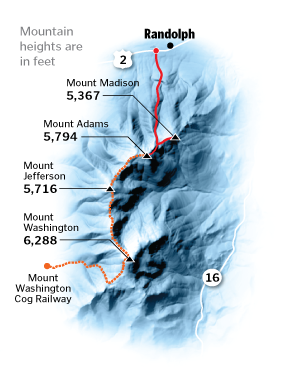
She had a complete down suit designed for cold and difficult mountaineering pursuits. She had mountaineering boots and full crampons. She had a light pack, goggles, headlight, and a hat. Her technology gear list included a GPS with tracks already loaded in case the visibility dropped. With the GPS, she could navigate the route without vision. When she reached tree line, she would turn on the GPS and check it periodically to ensure she didn't drift off course. She also carried a SPOT communication device. She had filed an emergency contact system with NOAA in the case of an emergency. One of several contacts were her friends in her Manhattan office. If they received a phone call this would mean that she was in trouble. Her husband was also on the list. They had emergency contact for Search And Rescue ("SAR") telephone numbers to call in that event. The idea was to travel light and fast. She had about 15 miles to travel, and a significant amount of elevation gain. It was a doable plan.
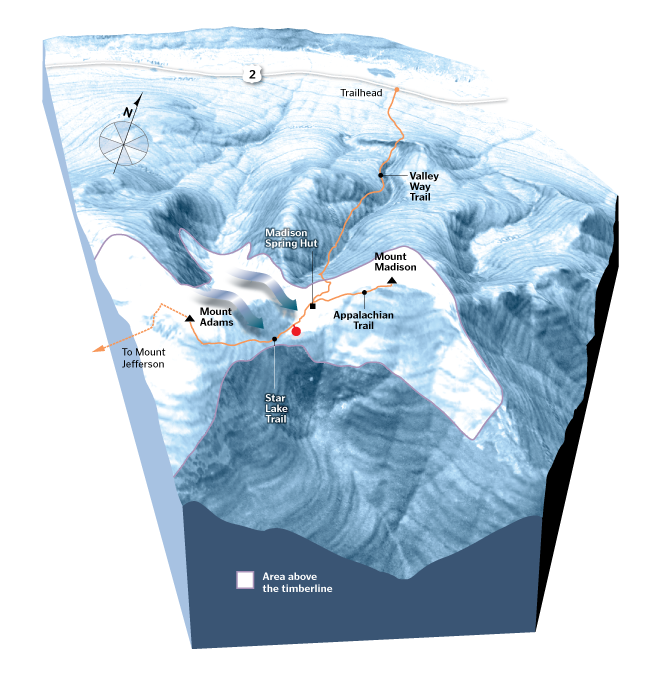
She stepped out of the car on the north side of the mountain range at 5 AM in the morning. On the summit it was -5F and there were 40mph winds. The weather forecast called for the winds to pick up significantly as the evening approached. Her plan was to reach the tree line by the time the winds picked up at the end of the day.
The parking lot was well below the tree line. She started up the Valley Way Trail towards the col between Mount Adams and Mount Madison. She would hike in the dark for the first 1-1/2 hours. She had a headlight to see the trail as she quickly ascended the mountain. If you have hiked this particular part of the White Mountain in New Hampshire, you too have seen the following sign that clear states the dangers of this hike:
"Try this trail only if you are in top physical condition, well clothed and carrying extra clothing and food. Many have died above timberline from exposure. Turn back at the first sign of bad weather."
It is always a sober reminder to all that there are dangers of hiking. Especially here on the Presidential Range of the White Mountains of New Hampshire. At this point 147 people had died hiking on this range. Not a small number, but Kate Matrosova had hiked a number of mountains that had similar dangers and long death list. But, the danger isn't to be taken lightly. Kate was exceptionally bright, and had already taken the dangers into consideration. She was a meticulous planner. But, with any plan, problems can crop up, and they must be overcome in a timely manner. Today would be no exception. There was little time to resolve problems if they occurred.
When Kate Matrosova hit the tree line she stopped and turned on her GPS to ensure that she didn't drift off course. At this point she wouldn't be within the safety of the woods. She would be in the open, and the wind would pick up considerably. There are no trail markers above the treeline. In some places there are rock cairns. In the summer months there is a worn path that is easy to follow. But with snow on the ground, both the trail and cairns would be below the snow's surface. Her GPS would be an important hiking tool to guide her safely along the correct path. Time was important, and drifting off course could cost her valuable time.
In the early morning, Kate Matrosova hit the col between Mount Adams and Mount Madison. Kate would take a left off the main trail and hike up to the summit of Mount Madison. Upon summiting Mount Madison, she would turn around and hike back down to the main path. By now, the winds had picked up. In fact, the winds picked far more then the weather forecast had predicted. Such is the nature of the White Mountains in New Hampshire. Our guess is that Kate had predicted winds of 40-60 mph with temperatures of -10F to -20F. It would be cold, but doable. When Kate reached the main trail again, she would take a left onto the Star lake Trail. She would pass the Madison Spring Hut at the intersection of these trails. This part of the main trail would take her to Mount Adams. At this point, the wind was blowing significantly more then the 40-60 mph. This slowed her down, caused her to start getting cold. Never-the-less, Kate would press on to Mount Adams.
It is believed that Kate Matrosova would summit Mount Adams around noon time. By the time she reached the summit, the winds where blowing well into the hurricane range. On this day, Mount Washington would record winds up to 141 mph and wind chills down to -85F. When Kate summited Mount Adams, she knew that should would not be able to finish the hike. She then decided to abort the hike and return down to col between Mount Madison and Mount Adams. She would then hike back down the Valley Way Trail to where she started. She would then call her husband to come pick her up.
As she descended back down the Star Lake Trail back to the Madison Spring Hut, she would encounter horrific winds. This would slow her down significantly, and cause her to become significantly hypothermic. With hurricane winds, her movement would be extremely slow. It was probably blowing her down many times. She would get up and continue the difficult traverse back to the hut. As she was approaching the hut, she would be blown about 100' downhill from the trail. We are presuming that she had some injuries from being blown over 100 feet in the air. It was 3:30pm in the afternoon. She would then activate her PLB and SPOT. Her husband was called, but his cell phone was turned off. Her office would also receive a phone call. The police and SAR received a GPS location where she actually was located. For SAR it was an ugly location.
Please note: There were a number of reports that only the PLB was recovered. But, another SAR person stated that she had a SPOT also. There is a lot of conflicting information about how she used these devices. At this time our theory is that she first used the PLB, which relayed the correct location. After a number of hours, she would then use her SPOT, which we believe sent the wrong GPS location (about 1 mile off course). During the night they would receive another 9 transmissions. It should be noted that the PLB only sends one signal. At this time we have a number of questions that are not resolved. The SPOT is capable of transmitting a signal down to -22F. It was colder then -22F that night. If we get an update, we will correct this case study.
Within minutes SAR, police, and Kate's husband would know that she was in deep trouble. Kate's husband knew that she would never activate the emergency beacon unless she was in real trouble. A check with Mount Washington Weather Station would show that it was -21F with winds of 77 mph. And, it was forecast to get significantly worse. Things would be bleak for Kate Matrosova as she laid face down in the snow. Sadly, she wasn't that far from the hut. But, in this kind of weather, it was like it was a million miles away.
The Game and Parks Officer would call Mountain Rescue Service. They had world-class climbers who knew these mountains, and had the best chance of rescuing her before she froze to death. Before SAR would reach the Valley Way Trail at 7 PM, they would receive a second emergency transmission from the SPOT with GPS coordinates below the treeline on the Valley Way Trail. The SAR team decided that Kate Matrosova must be moving, and is now in a safer place below treeline. The SAR team would proceed to the GPS coordinates of the second transmission instead of the first GPS location. This mistake would result in her death. But, to SAR, the second GPS location seemed like the logical choice.
SAR would take a detour off the Valley Way Trail and head to the second GPS coordinates. While bushwhacking through the forest they would encounter very deep snow. They were moving about 600' per hour. Around Midnight they would reach the GPS location and would not find Kate. It didn't take SAR long to realize that Kate Matrosova could not be at this location. They were having significant trouble moving with snowshoes. And, Kate didn't have snowshoes. So, they would abandon this 2nd GPS location as incorrect. Then a third GPS location would arrive. This would put her up near where she was actually located. It was -35F and wind would continue to blow at a horrific rate. At this point it was around mid-night, and they decided to abandon the search, and call in another SAR team in the morning. They would descend the Valley Way Trail. The first SAR team would arrive back at the parking lot at 3 AM.
The following morning at 9 AM the Androscoggin Valley Search and Rescue team was to head up the mountain to the original GPS location. By now, Kate Matrosova would send another 8 GPS locations out of desperation. Sadly, they ended up confusing SAR as to her exact location. It was -35F and the winds were steady at 100 mph. They would ascend the Valley Way Trail to the Madison Spring Hut. They would take a break from the wind at the hut. They would then move towards Mount Adams on the Star Lake Trail with an 11 man team searching the slopes for Kate Matrosova. Five hours (2 PM) after they started they would spot Kate Matrosova's body laying face down in the snow with no movement. She was several hundred feet off the trail. She was found without her backpack and crampons. She had her headlight on, and has cuts and scraps to her face. SAR theorized that a gust of wind picked her up and blow her 100+ feet off the trail. She died where she landed. But, she would struggle throughout the night to survive.
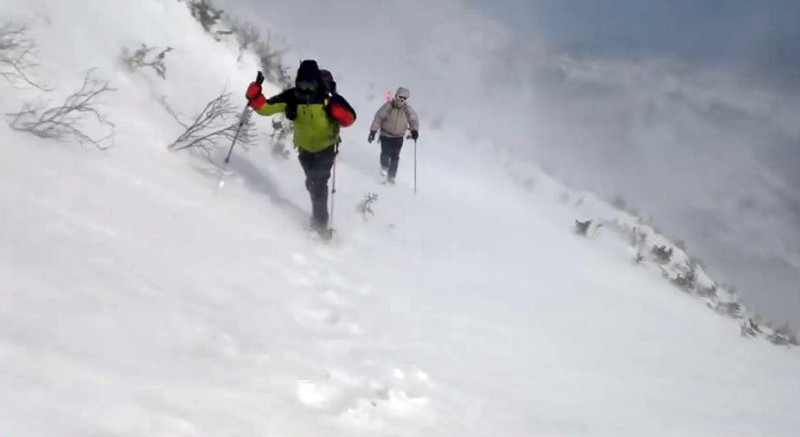 Image shows the Androscoggin Valley Search and Rescue team looking for Kate Matrosova
Image shows the Androscoggin Valley Search and Rescue team looking for Kate Matrosova
Review and Analysis of the Incident and the death of Kate Matrosova:
Catskill Mountaineer doesn't pass judgment on people's deaths in regards to negligence. There are way too many small pieces of evidence that we will never see. One small piece of evidence can completely change the direction of a story. Therefore, we will not discuss the negligence factor. Lastly, and most important: Kate Matrosova paid the ultimate price for her small mistakes. No need to further speak negatively and disrespectful of her. RIP Kate Matrosova. Unfortunately, some experienced hikers consider passing the negligence judgment as a sport. We don't. But, we would be foolish if we didn't go back and see what she did right, and what small mistakes she made to led to her demise. Maybe someone in the future can learn from this story.
Introduction Summary: Based upon most of the evidence, but not all the evidence, our overall conclusion was that she did some good planning, but she died due to small mistakes, conflicting use of the PLB and SPOT, and encountered some unfortunate luck. We concluded that multiple transmissions confused SAR as to her exact location. And this would mean the difference between life and death. We do not believe that the SPOT is a reliable emergency tool due to it's weak transmitter and inadequate temperature rating. The 400 milliwatt transmitter is too weak, and transmits very poor GPS locations for emergencies. A real PLB, with a 5000 milliwatt transmitter, would have saved her life. We believe that the use of both devices was one of the major causes of her death. If SAR had a good GPS location she would be alive today. If she had used the PLB with a single transmission, you wouldn't be reading this story.
Trip planning: Kate Matrosova did a good job researching and planning out the hike. The route she picked was 15 miles long with 8700' of vertical. In the late Spring with 25% snow and 75% dirt, it can be done in about 11 hours by a moderately fit hiker. Kate figured she was very fit and she calculated about 13 hours. This calculation appears reasonable in good weather. If it dragged past 13 hours, she had a headlamp. If she didn't have high winds, we believe that her 13 hour calculation would have been accurate in lower speed winds. Kate downloaded existing GPS tracks and loaded them into her GPS. She planned on using the tracks above treeline to avoid drifting off the path. This kept her from getting lost, and losing valuable time. The only issues with her plan was that the amount of time she need to complete the hike didn't leave much time to resolve problems. But, she didn't have a good plan for high winds, but she didn't expect them to be twice the original forecast. Kate probably figured that she could stop the hike and back track, or take a side trail if she encountered problems. But, with very high winds, her plan didn't count on bad luck.
Gear List: She had the complete down body suit needed for very cold weather hikes. She had mountaineering boots and crampons. She also had a GPS, PLB, SPOT, and map of the route. She didn't bring a sleeping bag, tent, and snowshoes. Since it was a day hike, she didn't want to bring extra weight. I can understand her position. But, there was no provision in the case where she didn't make it out of the woods that day. I believe that she planned on hiking until she was done. Even if she had to hike well into the night. But, she didn't plan for the case where she was forced to camp out overnight. In this case, it was a mistake to not have a sleeping bag and a bivy bag. Some questioned her not bringing snowshoes. Personally, I believe that she should have carried them. But, in the final analysis it probably didn't make a difference. The wind probably blew away any loose snow.
One of the major failures of Kate's gear list was the use of her PLB and SPOT. She should have only used the PLB. That would have resulted in only one GPS location transmitted to SAR. The SPOT didn't have the ability to collect and transmit her GPS location accurately. The SPOT also has a limit of -22F, where a PLB has a limit of -40F. The SPOT has a 400 milliwatt transmitter where a PLB has a 5000 milliwatt transmitter. We believe that the SPOT is a poor device for people in a life-threatening position. First you don't know if SAR got the transmission. Second, you don't know that the GPS location is correct. During the 12-15 hours she lived after being blown off the trail, she would send 11 transmissions. Some of the 11 GPS locations were over a mile away from the actual location. A PLB would have turned on the strobe, and she would have known that SAR was coming and they knew exactly where she was. With additional GPS locations as far as a mile away, this would lead SAR on a wild goose chase. This created a huge area for SAR to search. By the time they found Kate, she would be dead. There were reports that the US Coast Gurad flew a helicopter over the original GPS location. They would abandon the search due to high winds and low visibility. Very few people in the mountaineering community know of the limits of the SPOT. And, I am sure Kate Matrosova didn't know them either. She probably wondered why no one came for her. Out of desperation she probably kept hitting the button on the SPOT.
Weather forecast: The original weather forecast called for cold temperatures and moderate amount of wind. This forecast may not have stopped some experienced and capable hikers from going. But, all hikers would be concerned about the conditions, and what if conditions ended up worse then predicted. The Weathermen have difficulty in getting the forecast correct, so it is even harder for the hiker. I am sure Kate Matrosova checked the weather forecast before she left NYC. The time between when she checked it in NYC and when she started the hike would be a long period of time. If she had an up-to-date forecast at the trailhead, she might have done things differently. Unfortunately for Kate, the weather turned out to be significantly worse then originally predicted. This contributed to her death. Mount Washington Weather Observatory reported the maximum wind was 141 mph with wind chills down to -85F. The wind and temperature at Kate's final resting place were not as severe, but still too high for survival.
Solo versus a group Hike: Many people believe that hikers should not hike solo. Especially in the Winter. Many believe that Kate Matrosova was asking for trouble by hiking this route alone. Hiking alone allows the hiker to regulate their speed perfectly to match the temperature of their body. This is an advantage for the solo hiker. With two hikers, you are twice as likely to have an incident while hiking. The more people in a group, the more likely you are to have an incident. In severe weather events, other people often are unable to provide much help to the injured, so having more people in a group can be a negative. The primary advantage of a hiking group is if one of the hikers is knocked unconscious, the other hikers can call for help. Since Kate made 11 emergency transmissions, we are not sure that a larger group would have been an advantage. Splitting up the group is a violation of good mountaineering safety.
When to Abandon the Hike: Some believe that Kate Matrosova should have abandon the hike before she even started. But, some mountaineers relish the challenge of difficult weather. Some of Kate's friends were world class mountaineers, and Kate appeared to be moving in the direction of high-attitude technical climbing. She probably considered bad weather as a training exercise. If this is the case, then she under estimated the severity of weather on the Presidential Mountain Range. Kate's original forecast called for turbulent weather, but nothing extreme. With bad luck, it turned out to be extreme weather. If the weather was calmer, then the hike would have turned out okay.
After Kate has summited Mount Madison, she stopped at the hut to take a picture. She appeared to be in good shape, and there didn't seem to be an issue with continuing. Some believe that Kate should have abandon the hike at this point. She was probably behind schedule at this point and should have considered abandoning the hike. But, she probably believed that she could complete the hike safely.
Upon approaching Mount Adams the winds must have increased dramatically. As she was ascending, she should have considered turning around at that point. But, being a driven mountaineer, she probably figured that summiting Mount Adams would not change the outcome. After summiting Mount Adams, it was too late to change the outcome. She would abandon the hike after summiting Mount Adams. On her way down Mount Adams, she would be blown over 100 feet off the trail. We are presuming that she received injuries in being blown over 100' down the slope. We are presuming that her injuries prevented her from continuing to hike. At this time we do not have knowledge of the exact injuries. We do know that it ripped off her backpack, and cause injuries to her head.
Other factors: Unknown to Kate Matrosova, she actually had cell phone coverage at her final resting place. If she had checked her cell phone she could have called 911 and provided an accurate GPS location. We are presuming that Kate didn't even think that was possible. It is also known that many Smart Phones cannot operate at those temperatures, so it is possible that she might have tried to use her phone, but couldn't get it to work. Again, more bad luck.
After she was blown 100+ feet off the trail. She had cuts and abrasions to her face. Her backpack was ripped off her body. The forces of the fall probably caused other bodily injuries. If she could have gotten to the hut, which wasn't that far away, she could have sheltered her body from the wind and cold. But, we are presuming that the injuries were probably too great to continue. Small mistakes in the Winter can have very profound consequences. When problems occur in the Winter, the problems can be very unforgiving.
Summary of the death of Kate Matrosova:
The biggest mistake was the 11 emergency transmission. She was probably desperate, and kept hitting the button. It confused SAR, which drastically delayed them from reaching her in time. In the particular case, it was too late. She should have abandon the hike sooner. Especially when she fell behind time wise. When the winds got too high, she should have turned around sooner. She should have carried a sleeping bag and bivy. Lastly, she should have checked the weather just before leaving for the trailhead. In retrospect, they were all small mistakes, but in the Winter small mistakes can have profound consequences.
Ekaterina Matrosova 247 W 46th St Apt 1705 New York, NY 10036-1463
Charlie Farhoodi
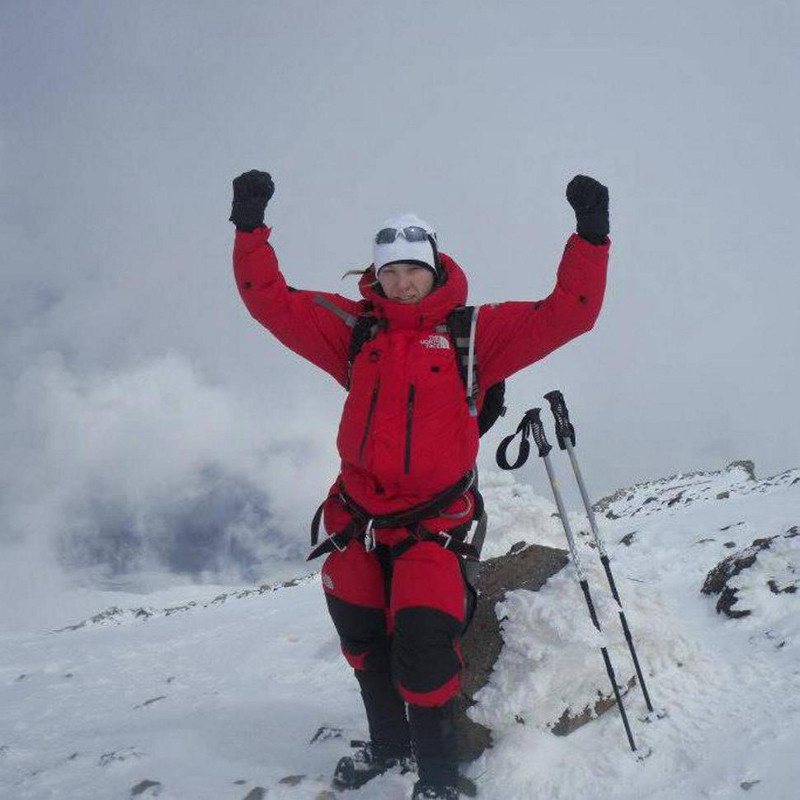 Kate Matrosova summits an unknown mountain
Kate Matrosova summits an unknown mountain
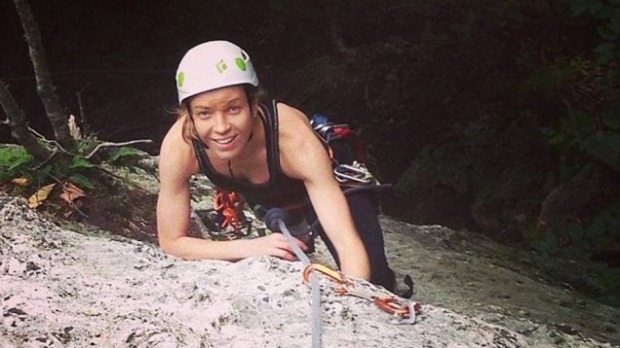 Kate Matrosova rock climbing
Kate Matrosova rock climbing
|

